‘I wear my body, without shame’
Images of the exposed African body have flooded colonial anthropological studies for centuries; either exoticised or allowed to be exposed when culturally sanctioned. But when acting upon it’s own autonomy the female body has also been used to claim space, and become an act of protest. The Fearless Collective collaborated with two local organizations, One in Nine campaign, formed as a response to the Zuma trial, and HOLAAfrica. Both organizations work together to document and showcase the lives of women and their stories, supporting women through the process of reporting sexual crimes and moving through justice systems. Together in South Africa, they explored the theme ‘Outside the lines of Body’.
Catch all the breathtaking photographs of the workshop, rituals, collectivisation and mural painting by fearless feminists on the streets of Johannesburg below:
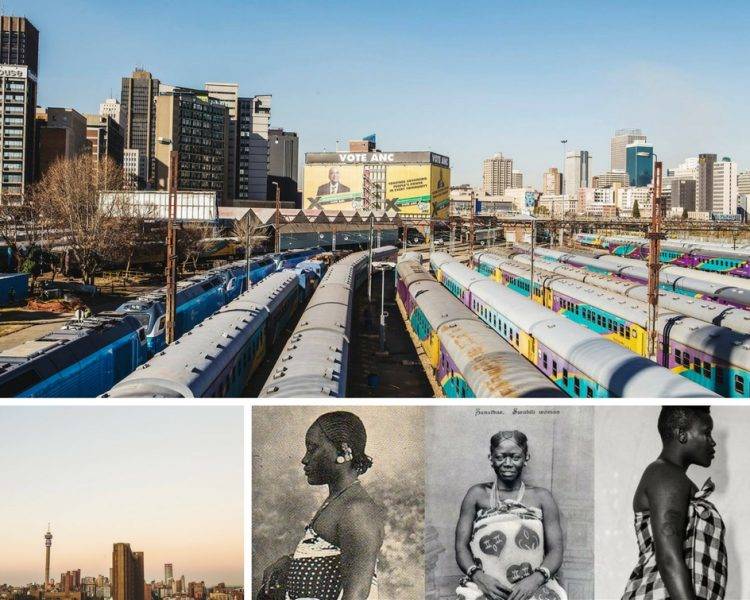
Johannesburg, a city mined for it’s gold, but lit by the sun is full of dualities. Ads rise above the city, some selling beauty products, others using skin to sell television sets, but the one face that is consistent is the face of Jacob Zuma. 2016 marks ten years since the current President of South Africa raped a family friend’s daughter. In court she was publicly shamed and one of the reasons stated as justification for her rape, was that she was wearing a Kanga, The kanga (ironically meaning to wrap or close), is worn by women throughout the African region. draped around the body, carrier of babies and wrapped around the head. The Kanga became a significant symbol in court, replaying the universal trope of women ‘inviting’ rape through what they wear and stripping women of agency and consent.
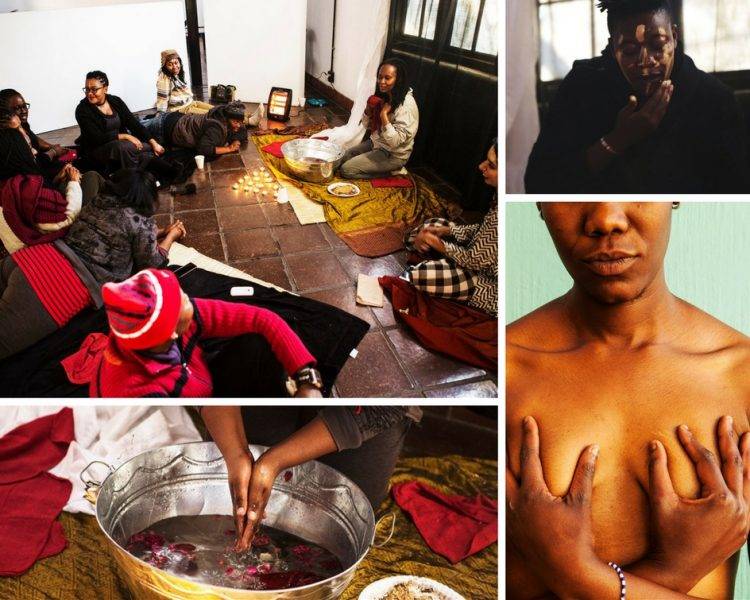
The need to engage with the online and offline space brought collaborators 1in9 Campaign, formed as a response to the Zuma trial and HOLAAfrica together, organisational partners who worked together to document and showcase the lives of women and their stories. In an intimate ritual, the workshop explored dual ideas of “pure” and “impure”. In the first part of the ritual, each woman sat before a tub of warm water, steeped in healing herbs, and began to wash off layers of shame that society had placed upon us. In this act of ritual purification and catharsis, participants released ‘shame’ imposed by the world and came into power for their choices and bodies. In the second part of the ritual, they took from a bowl of earth and gold dust (significant of all the gold mined in Joburg) and turned our ‘shames’ to pride and wore it as war paint.
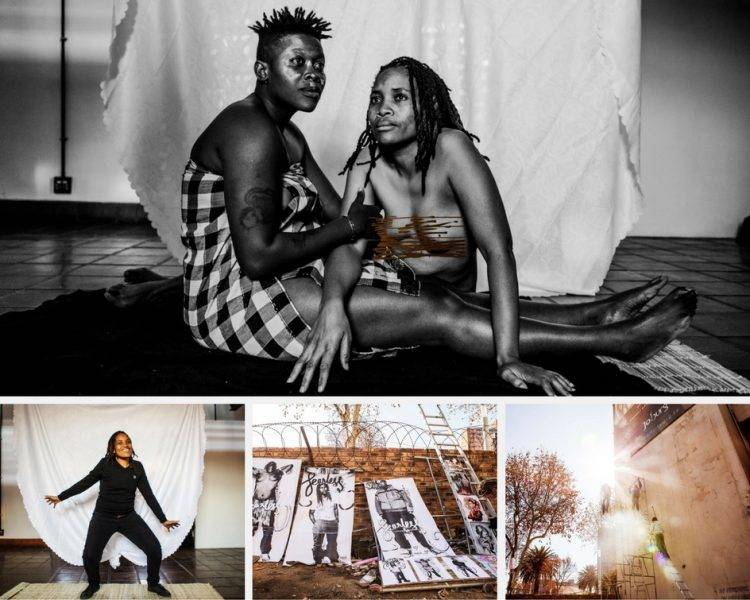
The photoshoot became into a playground of feminist ‘bad bitches’. Clothes came off, hair got wilder, laughs turned into cackles, and the private studio, became into a literal gold mine of imagery for the mural. These turned into a series of personal posters and affirmations of “shamelessness” or living without shame and fear. The final vision for the image, became one of solidarity. The female form would be vulnerable, powerful. There felt a need to create an image that spoke to all our stories. Soaked in sun, they started to climb towers into the sun, to wheatpaste their images of bodies.
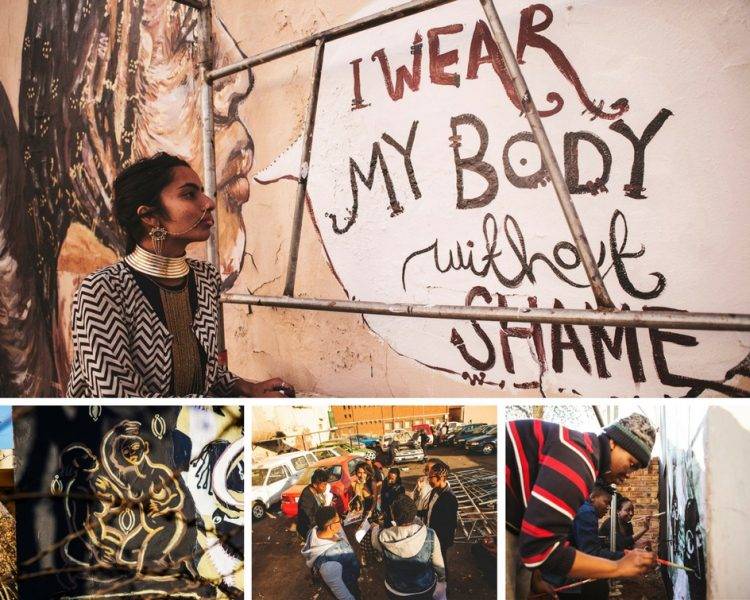
There is a kind of magic and reclaiming in the fearless process. Very often, the act of physically inhabiting spaces otherwise known as ‘unsafe’ for women is as much of a performance art as a visual art. Hands covered in gold paint, feet trusting sketchy metal scaffolding. Fearless’ lead artist Shilo Shiv Suleman makes rituals of climbing sky. The walls we eventually get permission to paint are marked out with symbols as if asking to be chosen and noticed.
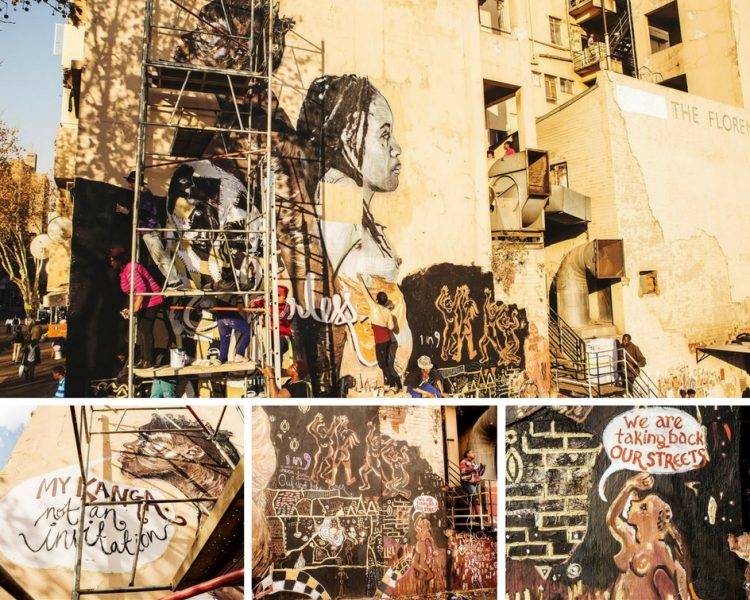
As they started to talk about the affirmation, the fearless feminists wanted to create two motions. One which defined a boundary, the other that liberated our self. And graphic women, clad in nothing but their bronze skin, danced their way across our mural. But raised their fists in protest, taking back their streets. And thus began the journey of unfolding our own stories, shedding shame, into the wall.
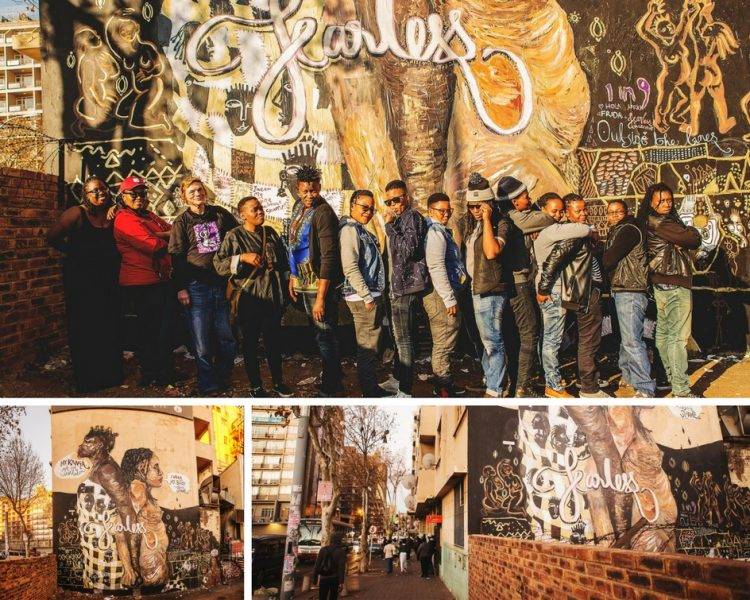
In a city mined for it’s gold but lit by the sun, at the intersection of a historical hill crowned by an old woman’s prison, and a neighbourhood considered notoriously unsafe by some. Two women stand defiant painted in black and gold on the walls of an old maternity ward, reclaimed by those seeking shelter. One of them wears a kanga around her body, the other stands exposed. Their hands are linked together as if linking the stories of countless women in South Africa (and the world!) that have stood for the autonomy of their bodies. Symbolizing the struggle of a woman raped by the current prime minister of South Africa ten years ago, they affirm- I wear my body without shame.
© All art by Shilo Shiv Suleman, Holaa! Africa and 1in9campaign members. Photography by Fabrice Bourgelle a.k.a. Photography by Focus. Captions by The Fearless Collective team. For more pictures and detailed storytelling, check out the Facebook album by The Fearless Collective.
Outside the Lines of Body is part of the #FearlesslyFRIDA initiative. The Fearless Collective is on a beautiful mission to paint the world with fierce and fearless colors as they collaborate with FRIDA and some of our grantee partners. Learn more about the global art tour of the #FearlesslyFRIDA partnership.
FearlesslyFRIDA is an initiative to encourage artivism into the young feminist movement. Would you like to be a part of this gorgeousness? Learn more about how you can participate by sending posters of how you have been #coloringoutsidethelines.
Share this on Facebook! | Tweet this! | Make a donation!
Edit Note: Khwezi , whose struggle was a major inspiration behind the mural, passed away on October 8, 2016. ‘Say her name. Fezeka Kuzwayo’: this was the final call after the death of Fezeka Ntsukela Kuzwayo in Durban at the age of 41, with a request to remember her as more than a rape victim, an identity that has been associated with her the past 10 years. Before her passing, Fezeka had been a symbol to all women fighting for justice of sexual assault victims as is evident with the rallying call ‘My Kanga is not an invitation’ which formed a core part of this project. For the past decade, Fezeka has been an activist, a friend and loved one to many despite her life being marred by the rape trial and the harsh treatment she experienced at the hands of those who supported Jacob Zuma. 1 in 9 Campaign also began to support Kezeka during this time, with the organisation not only made of her supporters but those who have loved and cared for her the past decade and even before that.